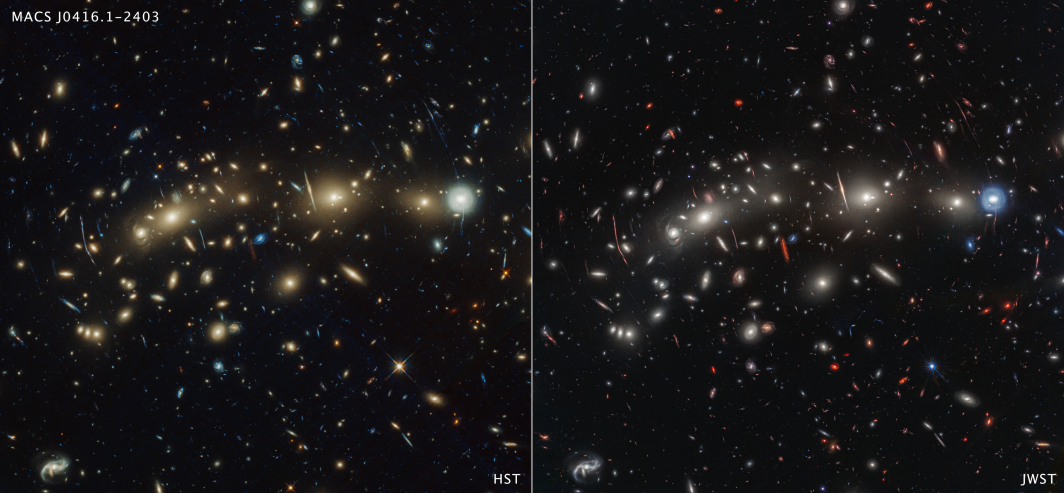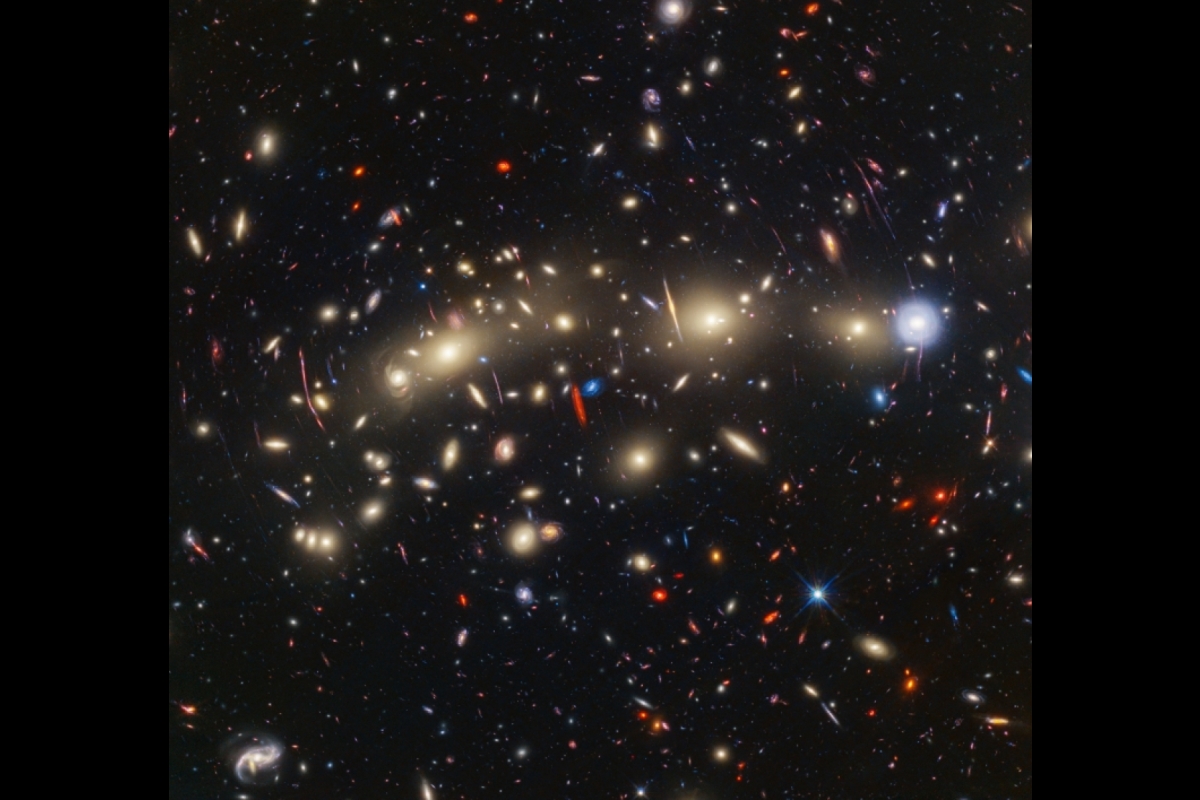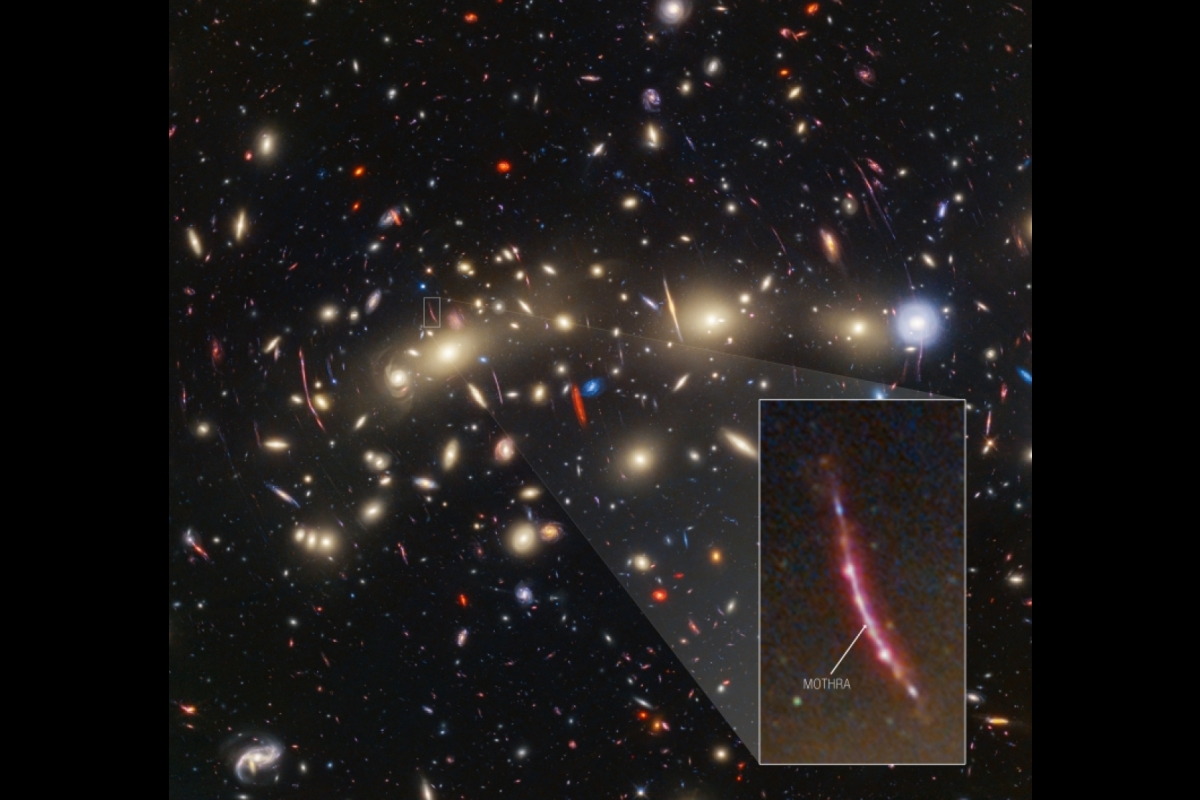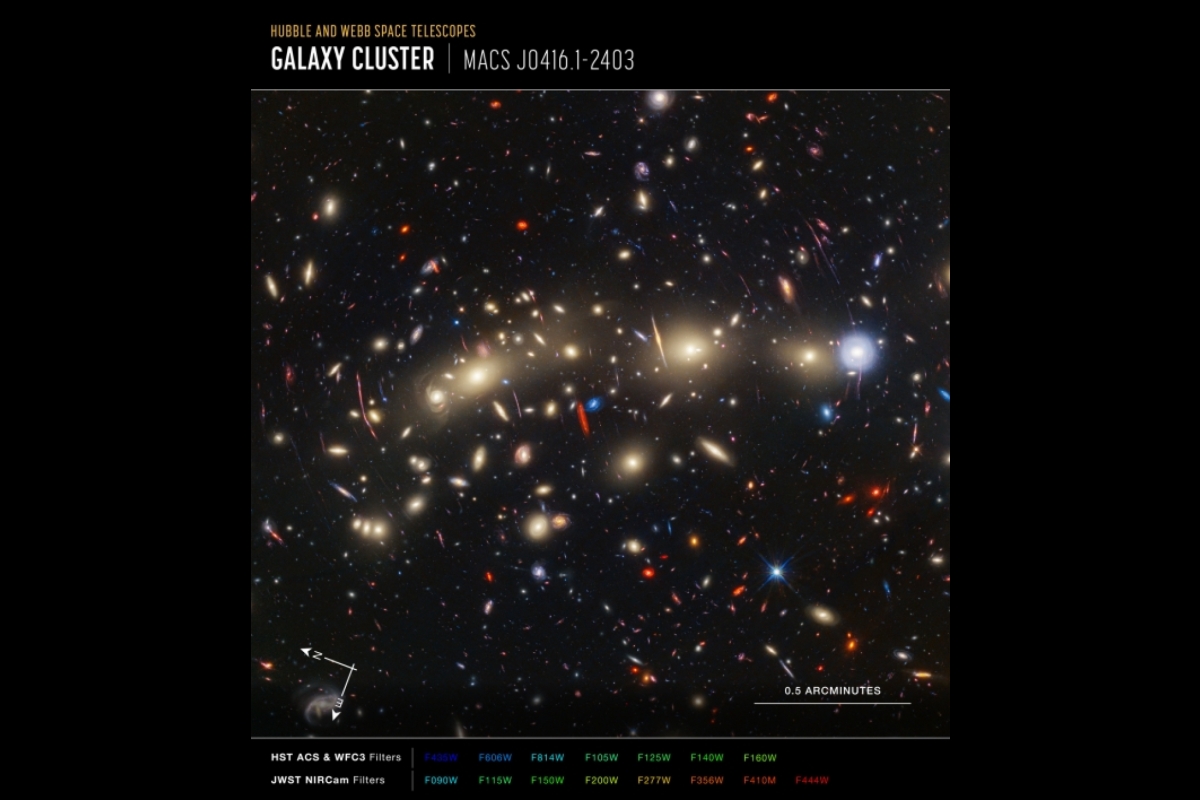Hubble, JWST together reveal vivid landscape of galaxies
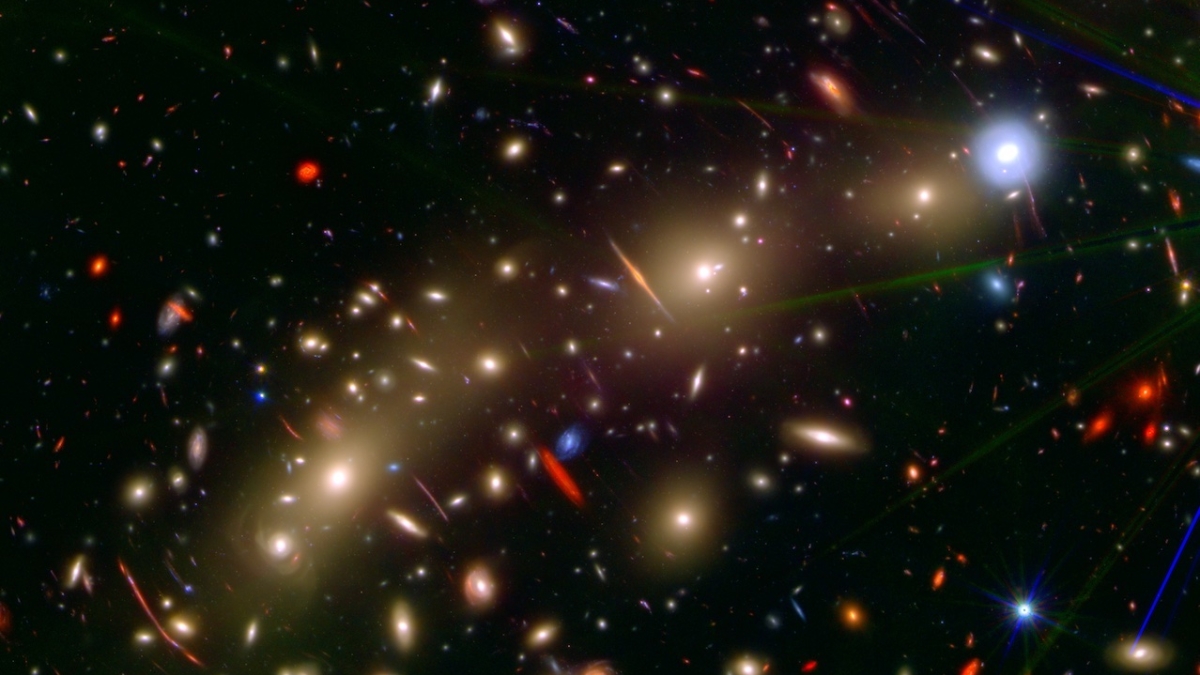
This panchromatic view of galaxy cluster MACS0416 was created by combining infrared observations from NASA’s James Webb Space Telescope with visible-light data from NASA’s Hubble Space Telescope. Image: MACS 0416 Webb and Hubble. Image courtesy NASA, STScI, ASU
Webb and Hubble have joined forces to study the galaxy cluster MACS0416, located about 4.3 billion light-years from Earth.
Their combined data yields a colorful panorama of blues and reds — colors that give clues to the distances of the galaxies. The resulting panchromatic image combines visible and infrared light to assemble one of the most comprehensive views of the universe ever taken.
On its own, the image itself is stunning. Researchers are already using these observations to fuel new scientific discoveries, including identifying gravitationally magnified supernovae and otherwise invisible, ordinary stars.
The image reveals a wealth of details that are only possible by combining the power of both space telescopes. It includes a bounty of galaxies outside the cluster and a sprinkling of sources that vary over time, likely due to gravitational lensing — the distortion and amplification of light from distant background sources.
This cluster was the first of a set of unprecedented, super-deep views of the universe from an ambitious, collaborative Hubble program called the Frontier Fields, inaugurated in 2014. Hubble pioneered searching for some of the intrinsically faintest and youngest galaxies ever detected. Webb's infrared view significantly bolsters this deep look by going even farther into the early universe with its infrared vision.
The pair of papers describing the discovery of the new time-domain discoveries in the infrared, which has been published in The Astrophysical Journal and Astronomy & Astrophysics, is led by Haojing Yan of the University of Missouri in Columbia and Jose Diego of the Instituto de Física de Cantabria in Spain, and includes Arizona State University co-authors Rogier Windhorst, Seth Cohen, Rolf Jansen and Jake Summers.
"We are building on Hubble's legacy by pushing to greater distances and fainter objects," said Windhorst, a Regents Professor and astronomer at ASU's School of Earth and Space Exploration and principal investigator of the PEARLS program (Prime Extragalactic Areas for Reionization and Lensing Science), which took the Webb observations.
What the colors mean
To make the image, in general, the shortest wavelengths of light were color-coded blue, the longest wavelengths red, and the intermediate wavelengths green. The range of wavelengths, from 0.4 to 5 microns, yields a particularly vivid landscape of galaxies.
Those colors give clues to galaxy distances: The bluest galaxies are relatively nearby and often show intense star formation, as best detected by Hubble. In contrast, the redder galaxies tend to be more distant, as detected by Webb. Some galaxies also appear very red because they contain copious amounts of cosmic dust that tends to absorb bluer colors of starlight.
"The whole picture doesn't become clear until you combine Webb data with Hubble data," Windhorst said.
This side-by-side comparison of galaxy cluster MACS0416 as seen by the Hubble Space Telescope in optical light (left) and the James Webb Space Telescope in infrared light (right) reveals different details. Both images feature hundreds of galaxies, however, the Webb image shows galaxies that are invisible or only barely visible in the Hubble image. Photo credit: NASA, ESA, CSA, STScI
Christmas Tree Galaxy Cluster
While the new Webb observations contribute to this aesthetic view, they were taken for a specific scientific purpose. The research team combined their three epochs of observations, each taken weeks apart, with a fourth epoch from the CANUCS (Canadian NIRISS Unbiased Cluster Survey) research team.
The goal was to search for objects varying in observed brightness over time, known as transients.
“By re-imaging the same cluster multiple times, we knew we would find some interesting objects beyond what the spectacular single epoch image showed, and these observations exceeded our expectations,” said Cohen, associate research scientist at ASU.
They identified 14 such transients across the field of view. Twelve of those transients were located in three galaxies that are highly magnified by gravitational lensing and are likely to be individual stars or multiple-star systems that are briefly very highly magnified. The remaining two transients are within more moderately magnified background galaxies and will likely be supernovae.
"We're calling MACS0416 the Christmas Tree Galaxy Cluster, both because it's so colorful and because of these flickering lights we find within it. We can see transients everywhere," said Yan, an ASU PhD graduate who is now at the University of Missouri in Columbia and lead author of one paper describing the scientific results.
Finding so many transients with observations spanning a relatively short time frame suggests that astronomers could find many additional transients in this cluster and others like it through regular monitoring with Webb.
“Together with massive galaxy clusters, acting as nature’s magnifying glass, JWST has proven to be an extremely powerful instrument for studying transients and variable sources of astrophysical and cosmological interest,” said Jansen, a senior research scientist at ASU.
Video by Steve Filmer/ASU
A kaiju star
Among the transients the team identified, one stood out in particular. Located in a galaxy that existed about 3 billion years after the Big Bang, it is magnified by a factor of at least 4,000.
The team nicknamed the star system "Mothra" in a nod to its "monster nature," being both extremely bright and extremely magnified. It joins another lensed star the researchers previously identified that they nicknamed "Godzilla." (Both Godzilla and Mothra are giant monsters known as kaiju in Japanese cinema.)
"The extreme resolution of the Webb images allow us to probe the lensed arcs of galaxy clusters for transients such as Mothra," said Summers, an undergraduate research aide at ASU.
Interestingly, Mothra is also visible in the Hubble observations that were taken nine years previously. This is unusual because a very specific alignment between the foreground galaxy cluster and the background star is needed to magnify a star so greatly. The mutual motions of the star and the cluster should have eventually eliminated that alignment.
The most likely explanation is that there is an additional object within the foreground cluster that is adding more magnification. The team was able to constrain its mass to be between 10,000 and 1 million times the mass of our sun. The exact nature of this so-called "milli-lens," however, remains unknown.
"The most likely explanation is a globular star cluster that's too faint for Webb to see directly," said Diego, lead author of the paper detailing the finding. "But we don't know the true nature of this additional lens yet."
The Webb data shown here were obtained as part of PEARLS GTO program 1176.
The James Webb Space Telescope is the world's premier space science observatory. Webb is solving mysteries in our solar system, looking beyond to distant worlds around other stars, and probing the mysterious structures and origins of our universe and our place in it. Webb is an international program led by NASA with its partners, the European Space Agency and the Canadian Space Agency.
The Hubble Space Telescope is a project of international cooperation between NASA and ESA. NASA's Goddard Space Flight Center in Greenbelt, Maryland, manages the telescope. The Space Telescope Science Institute in Baltimore, Maryland, conducts Hubble and Webb science operations. The institute is operated for NASA by the Association of Universities for Research in Astronomy in Washington, D.C.
For more information and to download the released high-resolution images, please visit https://hubblesite.org/contents/news-releases/2023/news-2023-146.html.
This press release was written by Christine Pulliam Space Telescope Science Institute, with contributions from Kim Baptista from ASU's School of Earth and Space Exploration.
More Science and technology

Hack like you 'meme' it
What do pepperoni pizza, cat memes and an online dojo have in common?It turns out, these are all essential elements of a great…

ASU professor breeds new tomato variety, the 'Desert Dew'
In an era defined by climate volatility and resource scarcity, researchers are developing crops that can survive — and thrive —…

Science meets play: ASU researcher makes developmental science hands-on for families
On a Friday morning at the Edna Vihel Arts Center in Tempe, toddlers dip paint brushes into bright colors, decorating paper…


